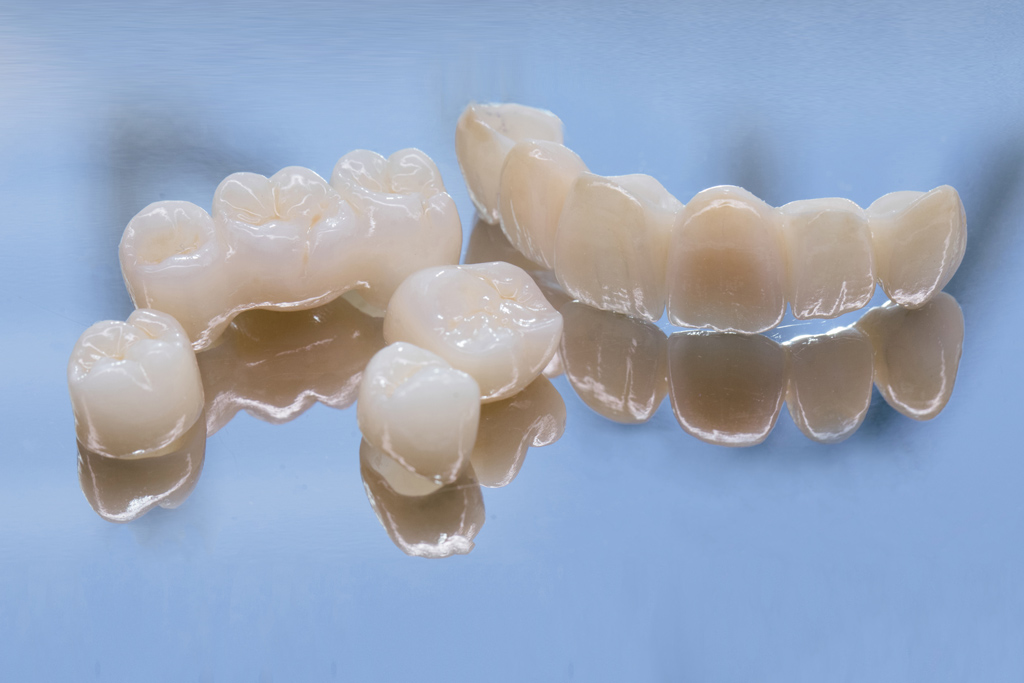
Crown & Bridgework
At times, a tooth may require more than a simple restoration to get the job done. That’s where dental crowns come in. These all encompassing restorations act to hold, restore and protect your teeth giving it longer-lasting protection than your average filling.
When a tooth becomes severely structurally compromised due to deep decay, cracks or from wear and tear, a simple filling may not be enough to help protect the tooth for the rest of its natural lifespan.
More often than not, more of the tooth will end up breaking as the tooth has been severely weakened from being fixed up or worn multiple times. This is also true after root canal treatment (which is why dentists recommend crowns for these teeth in the long run).
Enter dental crowns; these artificial caps act to replicate the natural shape of your tooth, quite literally holding a tooth together to prevent further damage.
If you have a gap next to teeth which require crowns, a dental bridge could be a suitable option.
This is a set of joined crowns which will fill the empty space next to a crowned tooth – literally “bridging the gap” created by one or more missing teeth. Unlike dentures, bridges are a fixed (non-removable) solution which also offers the benefit of protecting adjacent teeth.
FAQs
Can I get away with a filling on a tooth instead of a crown?
Unfortunately, once a tooths’ structural integrity is failing because of large restorations, deep cavities or cracks, a dental crown is the recommended long-term option for a tooth. While fillings may work in the short run, the period of time before more of the tooth cracks away or the filling dislodges becomes shorter and shorter.
In addition, you may run the risk that a tooth cracks too heavily that there is insufficient tooth remaining to perform any work on it at all !
How long does treatment take?
Crown/Bridge treatments typically take 2 visits, the first being a reduction/tooth preparation appointment which can take around 90 – 120 minutes. During this visit, we reduce the tooth to make space for the crown before taking an impression or an intra-oral scan. Don’t worry, we don’t leave your tooth like that, we then fabricate a temporary crown to fit over it while waiting for the final result.
The next visit, which is 2-3 weeks away, is the crown insertion appointment which takes roughly 20-30 minutes. During this visit, we try-in the crown to make sure it fits and looks good before finally inserting it. If anything is not satisfactory, additional visits may be required to get a perfect result for you.
Will my health fund pay for my crown and bridge?
It depends. Crown and bridges are within the category of major dental work. Depending on the level of cover of your health fund, it is not uncommon to see more than half of the cost to be covered by your health fund. If you require this treatment, your dentist will provide you with a quote containing item codes which can be brought to your health fund to determine your out of pocket costs.
Can I set up a payment plan for my treatment?
Definitely. Crowns and bridges admittedly cost a lot more than your standard dental treatment but the Dental Club offers multiple flexible financing options such as Zippay, Afterpay and Denticare. Talk to one of our friendly dentists for a consult and then speak to one of our lovely front desk staff who can discuss your options with you.
How do I take care of my crown and bridge?
The most important tip is good Oral hygiene. Like the rest of your teeth, brushing and flossing is essential, especially where the crowns meets the gums. In addition, if you have a bridge, a special type of floss called superfloss can be used to clean underneath the suspended crown.
Next is proper use of the crown/bridge. While it may be tempting to go away and start chewing nuts and opening bottles with your new crown, this is a recipe for disaster! A good key message is: – whatever you SHOULDN’T chew/bite on with your teeth, don’t bite on with your crown or bridge.
Finally, remember your checkups. Your dentist will keep an eye on all your teeth including your crowns to let you know how their condition is coming along. They will also give you tips and hints to make sure you’re on your way to making that crown/bridge last the long haul.
